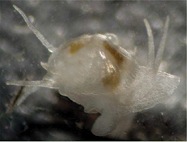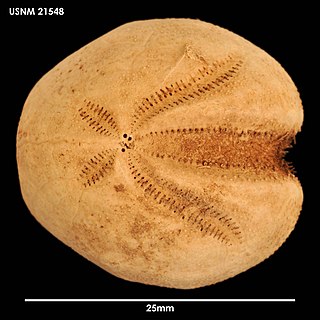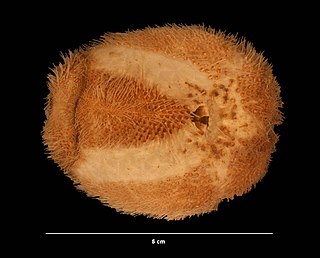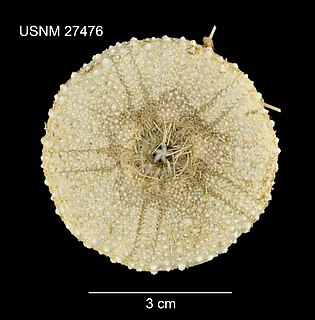
Galeommatidae is a family of small and very small saltwater clams, marine bivalve molluscs in the order Galeommatida.
Aeropsis fulva is a species of sea urchin of the family Aeropsidae. Their armour is covered with spines. It is placed in the genus Aeropsis and lives in the sea. Aeropsis fulva was first scientifically described in 1898 by Alexander Emanuel Agassiz.
Agassizia excentrica is a species of sea urchin of the family Prenasteridae. The species was first scientifically described in 1869 by Alexander Agassiz.
Aporocidaris fragilis is a species of sea urchin of the family Ctenocidaridae. It is well-armoured with spines. It is placed in the genus Aporocidaris and lives in the sea. Aporocidaris fragilis was first scientifically described in 1907 by Alexander Emanuel Agassiz & Hubert Lyman Clark.

Aporocidaris milleri is a species of sea urchin of the family Ctenocidaridae. Their armour is covered with spines. It is placed in the genus Aporocidaris and lives in the sea. Aporocidaris milleri was first scientifically described in 1898 by Alexander Emanuel Agassiz.
Araeosoma coriacea is a species of sea urchin of the family Echinothuriidae. Their armour is covered with spines. It is placed in the genus Araeosoma and lives in the sea. Araeosoma coriacea was first scientifically described in 1879 by Alexander Emanuel Agassiz, an American scientist.

Araeosoma coriaceum is a species of sea urchin of the family Echinothuriidae. Their armour is covered with spines. It is placed in the genus Araeosoma and lives in the sea. Araeosoma coriaceum was first scientifically described in 1879 by Alexander Emanuel Agassiz, an American scientist.

Araeosoma leptaleum is a species of sea urchin of the family Echinothuriidae. Their armour is covered with spines. It is placed in the genus Araeosoma and lives in the sea. Araeosoma leptaleum was first scientifically described in 1909 by Alexander Emanuel Agassiz & Hubert Lyman Clark.
Araeosoma tessellatum is a species of sea urchin of the family Echinothuriidae. Their armour is covered with spines. It is placed in the genus Araeosoma and lives in the sea. Araeosoma tessellatum was first scientifically described in 1879 by Alexander Emanuel Agassiz.
Aspidodiadema tonsum is a species of sea urchin of the family Aspidodiadematidae. Their armour is covered with spines. It is placed in the genus Aspidodiadema and lives in the sea. Aspidodiadema tonsum was first scientifically described in 1879 by Alexander Emanuel Agassiz.

Brisaster moseleyi is a species of sea urchins of the family Schizasteridae. Their armour is covered with spines. Brisaster moseleyi was first scientifically described in 1881 by Alexander Emanuel Agassiz.
Brisaster townsendi is a species of sea urchins of the family Schizasteridae. Their armour is covered with spines. Brisaster townsendi was first scientifically described in 1898 by Alexander Emanuel Agassiz.
Brissopsis columbaris is a species of sea urchins of the family Brissidae. Their armour is covered with spines. Brissopsis columbaris was first scientifically described in 1898 by Alexander Emanuel Agassiz.

Brissopsis pacifica is a species of sea urchins of the family Brissidae. Their armour is covered with spines. Brissopsis pacifica was first scientifically described in 1898 by Alexander Emanuel Agassiz.

Waldo is a genus of small marine clams in the family Galeommatidae. It includes five species which are all obligate commensals of sea urchins. They are found in the southern Atlantic and Antarctic Oceans, with the exception of Waldo arthuri which is found in the northeastern Pacific Ocean.
Ceratophysa ceratopyga is a species of sea urchins of the Family Pourtalesiidae. Their armour is covered with spines. Ceratophysa ceratopyga was first scientifically described in 1879 by Alexander Emanuel Agassiz.
Ceratophysa rosea is a species of sea urchins of the Family Pourtalesiidae. Their armour is covered with spines. Ceratophysa rosea was first scientifically described in 1879 by Alexander Emanuel Agassiz.

Chaetodiadema pallidum is a species of sea urchins of the Family Diadematidae. Their armour is covered with spines. Chaetodiadema pallidum was first scientifically described in 1907 by Alexander Emanuel Agassiz and Hubert Lyman Clark.
Cidaris abyssicola is a species of sea urchin in the Family Cidaridae. Cidaris abyssicola was first scientifically described in 1869 by Alexander Emanuel Agassiz.
Brisaster is a genus of echinoderms belonging to the family Schizasteridae.









